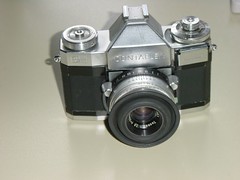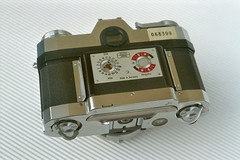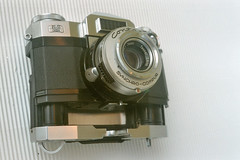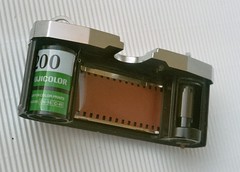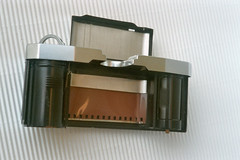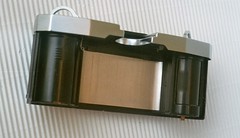Contaflex (SLR)

|
| Picture by Acolla (Image rights) |
The Contaflex series is a family of 35mm leaf-shuttered SLRs, produced by Zeiss Ikon in the 1950s and 1960s. (In 1935 the company had a "Contaflex" TLR.)
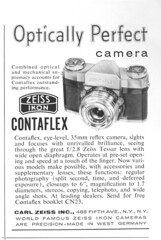
|
| Contaflex ad in National Geographic, January 1958 (Image rights) |
Contents
- 1 Context
- 2 The Contaflex I and II
- 3 The Contaflex III and IV
- 4 The Contaflex Alpha and Beta
- 5 The Contaflex Rapid and Super
- 6 The Contaflex Prima
- 7 The Contaflex's exchangeable back
- 8 The Contaflex Super (new) and Super B
- 9 The Contaflex Super BC and S
- 10 The Contaflex lenses
- 11 The Contaflex 126
- 12 The Weber SL75
- 13 Notes
- 14 Bibliography
- 15 Links
Context
When it was introduced in 1953, the Contaflex SLR was the first 35mm SLR equipped with a between-the-lens leaf shutter. That combination requires a very complex cycle of operations when the release button is pressed. The advantages are compactness and synchronized flash up to the maximum shutter speed. The inconveniences are limited lens interchangeability and mechanical complexity. In particular, no Contaflex model has a rapid return mirror, and all suffer from a limited range of lenses, from 35mm to 115mm focal length.
Soon enough the Voigtländer, Braun and Kodak AG companies would jump on the wagon and produce their own leaf-shutter 35mm SLRs: the Voigtländer Bessamatic and Ultramatic CS, the Braun Paxette Reflex and the Kodak Retina Reflex. Others, like Agfa, Pentacon and many Japanese makers, would follow, for example Minolta with it's Minolta ER. However the complexity of the mechanical design required fine assembly and the other models are not reputed for their reliability, while the Contaflex, Retina Reflex and Bessamatic performed correctly and sold in quantities.
The Contaflex I and II
The Contaflex I, launched in 1953, was equipped with a fixed Zeiss Tessar 45mm f:2.8 lens with front-cell focusing. The very first Contaflex I had a Synchro-Compur shutter with the old scale of shutter speeds (1-2-5-10-20-50-100-200-500), but very soon it adopted the new scale 1-2-4-8-15-30-60-125-250-500.
The Contaflex II, introduced the following year, was the same camera with an uncoupled selenium meter added to one side of the front plate.
Both had a fixed lens but to the front of which could be attached a supplementary lens, called the Teleskop 1.7x.
The Contaflex III and IV
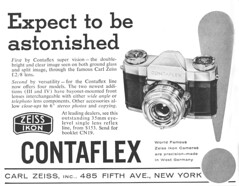
|
| Contaflex ad in National Geographic, May 1957 (Image rights) |
The Contaflex III, launched in 1956, was the same as the I, but equipped with a Zeiss Tessar 50mm f:2.8 with helical focusing. The front element of the lens was removable and could be replaced by supplementary lenses, discussed in the section Contaflex lenses.
The Contaflex IV, introduced the same year, was the same camera with the uncoupled meter inherited from the Contaflex II.
The Contaflex Alpha and Beta
The Contaflex Alpha and Contaflex Beta, both introduced in 1957, were based on the same body but equipped with a Zeiss Pantar 45mm f:2.8 three-element lens and a Prontor Reflex shutter up to 1/300. They were the cheaper models of the line. The Alpha had no meter and the Beta had the selenium meter of the II and IV.
The front element of the lens could be interchanged with others for 30mm f:4 and 75mm f:4. These could also be used on the Contina III 35mm viewfinder camera.
The Contaflex Rapid and Super
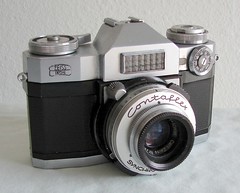
Contaflex Super (old)
Picture by Montanaman1 (Image rights)
The Contaflex Rapid was introduced in 1958 and had a slightly longer body, a built-in accessory shoe, a winding lever and a rewind crank. It was the meterless version.
The Contaflex Super, launched the following year, was based on the Rapid and had a coupled selenium exposure meter on the front side of the prism. It is easily recognized by the aperture setting wheel on the front plate. The meter's match-needle instrument is visible in the finder as well as on the top plate from the outside. It is not to be confused with the Super (new) that will be discussed later. The Super has a special exposure setting conception. The speed setting ring has two grips to provide lever power for exposure setting which is needed since turning the speed ring automatically turns the aperture ring into the opposite direction. The thumb-wheel around the camera's film speed setting knob is the device to turn the aperture ring on the lens barrel independently and to change its relation to the speed ring so that other speed/aperture-combinations become possible. If this device is used for match-needle metering the speed ring with the grips allows to switch easily to other exposure-setting combinations without getting out of correct exposure values as shown by the meter.
The Rapid and Super could take the same supplementary lenses as the III and IV. The cameras had also the same focusing concept, with two extra grips on the focusing ring which moves the whole lens forwards and backward when turned.
The Contaflex Prima
The Contaflex Prima, launched in 1959 and sold until 1965, was based on the body of the Rapid, but with the Pantar lenses and the Prontor shutter like the Alpha and Beta. The Prima had a coupled exposure meter placed on the side of the front plate, different from that of the Super.
The Prima could take the Pantar supplementary lenses like the Alpha and Beta.
The Contaflex's exchangeable back
An alternate camera back was offered by Zeiss Ikon, a camera back that fit for some Rapid, early Super and Prima models. The 35mm film had to be loaded into the film back which held the film capsule itself light tight, as well as the take-up reel. Even the image plane could be covered light tight with a removable sliding door so that the whole film back could be removed mid-roll and exchanged by another loaded film back. This made the cameras camera attractive for ambitious tourists who wanted to use one fine camera for both slide films and negative films.
The Contaflex Super (new) and Super B
The Contaflex Super (new) and Contaflex Super B are very similar cameras. Both have a new body design, both longer and more bulky. The information about which came first is a bit contradictory in some reference books, but it seems the Super (new) was launched in 1962, introducing the new body design and a new selenium exposure meter in a prominent rectangle marked Zeiss Ikon in front of the prism. The aperture wheel was replaced by a more traditional aperture ring, and the meter read-out was visible both on the exterior and in the finder.
The Super B was launched in 1963, and added a shutter-priority automatic aperture, and maybe some other small changes.
The new body of the Super (new) and Super B allowed to take magazine backs, interchangeable with a partly exposed film inside. But of course the new film backs were wider as the redesigned cameras were. (Magazine backs, rare among 35mm cameras, were also supplied for the Zeiss Ikon Contarex.)
From the Super (new) and Super B, the Zeiss Tessar 50mm f:2.8 lens was recomputed and supposedly performed better. They could still take the same supplementary lenses, with one exception discussed in the relevant section.
The Contaflex Super BC and S
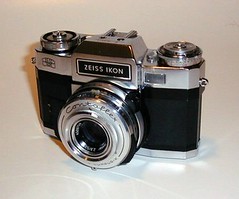
Contaflex Super BC
Picture by Bill Strong (Image rights)
The Contaflex Super BC was introduced in 1965, and was a Super B with the selenium meter replaced by a CdS through-the-lens exposure meter. It still had a black rectangle marked Zeiss Ikon on the front of the prism, but it was only decorative. It had a battery compartment at the bottom front.
The Contaflex S was the last variant, introduced in 1968, and was simply a renamed Super BC. It had a black rectangle marked Contaflex S on the front, and a different, newer Zeiss Ikon logo. It proudly sported the word Automatic on the front of the shutter.
The Super BC and S could take the magazine backs, as well as the usual supplementary lenses.
Both the Contaflex Super BC and S were sold in chrome or black; they were the only Contaflex models to be produced in black.
The Contaflex lenses
We have already seen that the Contaflex I and II could only take the Teleskop 1.7x supplementary lenses, and that the Alpha, Beta and Prima had their own limited range of Pantar supplementary lenses.
The models III, IV, Rapid, Super, Super (new), Super B, Super BC and S all have a Zeiss Tessar 50mm f:2.8 lens (27mm screw-in or 28.5mm push-on filters) with interchangeable front element. All of them can take a small range of supplementary lenses:
- Zeiss Pro-Tessar 35/4 (49mm filters), later replaced by the Pro-Tessar 35/3.2 (60mm screw-over filters)
- Zeiss Pro-Tessar 85/4 (60mm screw-over filters), later replaced by the Pro-Tessar 80/3.2 (60mm filters)
- Zeiss Pro-Tessar 115/4 (67mm filters)
- Monocular 8x30B, equivalent to a 400mm lens (attaches to the 50mm f/2.8 Tessar lens).
There was also a Zeiss Pro-Tessar M 1:1 supplementary lens, that kept the focal length of 50mm but allowed 1:1 reproduction. The effective speed of the M 1:1 lens is f/5.6. The 50mm standard front elements, as well as the Pro-Tessar M 1:1 elements, were different between the early models III, IV, Rapid and Super with the old model of Tessar, and the later models Super (new), Super B, Super BC and S with the recomputed Tessar. It appears that the mount was very slightly modified, and it seems physically impossible to mismatch the elements as the journal diameter above the bayonet mount had been reduced by approximately .006"
There were also stereo attachments:
- Steritar A for the Contaflex I and II
- Steritar B for the other Tessar-equipped models
- Near Steritar for close up stereo pictures .2 - 2.5 meters
(Normally interchangeable with the older Tessar line of Steritar B camera lenses)
- Steritar D for the Pantar-equipped models
A complete line of these Contaflex Steritar lenses can be seen at (http://www.flickr.com/photos/12670411@N02/)
The Contaflex 126
The Contaflex 126 is a completely different body. Its only relation to the rest of the Contaflex family is its name. It was introduced in 1967 to accept Kodak 126 (Instamatic) cartridges. It was one of the very few SLRs taking 126 film, and one of the very few ambitious cameras using that film. (Two other examples of 126 SLRs are the Rolleiflex SL26 and Kodak Instamatic Reflex.)
The Contaflex 126 is a SLR with a focal-plane shutter and interchangeable lenses. The range of lenses was:
- Zeiss Distagon 25/4
- Zeiss Distagon 32/2.8
- Zeiss Pantar 45/2.8, three-element, cheaper
- Zeiss Tessar 45/2.8, four-element, better
- Zeiss Sonnar 85/2.8
- Zeiss Tele-Tessar 135/4
- Zeiss Tele-Tessar 200/4
The Contaflex 126 lenses are often confused with other lenses by the sellers. They can only be used on the Contaflex 126 body, that can only take the obsolete 126 cartridge, so the value of these lenses is not very high, despite their famous names.
The Weber SL75
When Zeiss Ikon stopped making cameras in 1972, they had prototypes in various stages of development. One of them was the SL725, which would be a successor to the Contaflex line with an electronic shutter. The prototype ended in the hands of a company named Weber, which presented the camera at a Photokina show under the name Weber SL75 could not afford to put it into production, and did not find a partner to do so. The lens mount was a modification of the Contarex mount. Carl Zeiss advertised a range of lenses for the Weber SL75, all with the T* multicoating:[1]
- 18/4 Distagon
- 25/2.8 Distagon
- 35/2.8 Distagon
- 50/1.4 Planar
- 85/2.8 Sonnar
- 135/2.8 Sonnar
- 200/3.5 Tele-Tessar
An eBay seller seems to have uncovered a small stock of the Planar lens, and has recently sold a couple of them. No SL75 body seems to have surfaced though, and the only picture found on the web is here.
Notes
- ↑ Source: Zeiss prospectus from 1974.
Bibliography
- Barringer, C. and Small, M. Zeiss Compendium East and West — 1940–1972. Small Dole, UK: Hove Books, 1999 (2nd edition). ISBN 1-874707-24-3.
Links
In English :
- Contaflex page at www.retrography.com by Simon Simonsen, Denmark
- At OrphanCameras.com Contaflex instruction manuals
- Contaflex Camera Manuals : Photo-Manuals.com by Ben Squire
In French :
- Pages at www.collection-appareils.com by Sylvain Halgand
- Contaflex 126
- Contaflex I
- Contaflex II
- Contaflex IV
- Contaflex super
- Contaflex super 10127
- Contaflex super B
In Japanese:
| Zeiss Ikon Classic Cameras |
|---|
| Contax | Contaflex (TLR) | Super Nettel | Nettax | Tenax II | Tenax I | Ikoflex | Super Ikonta
Contax S | Contaflex (SLR) | Contarex | Icarex | SL706 |
